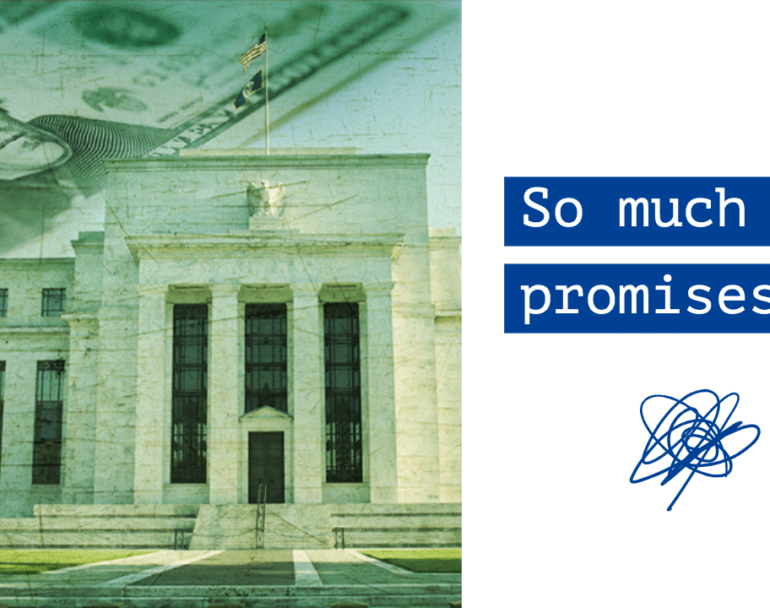
Federal Reserve Appears Poised to Resume Monetizing U.S. Government Debt
By: Mike Maharrey
It looks like the Federal Reserve is about to get back into the bond business and help the US government deal with its massive debt.
The Treasury Department announced yesterday that it will not have to borrow as much money in the third quarter of fiscal 2019 as originally anticipated. But this is not because of a slowdown in government spending. According to a Treasury official cited by Reuters, the reason for the lower borrowing estimate is due to an anticipated increase in Fed Treasury holdings as the central bank ends its balance sheet reduction program.
In a statement, the Treasury Department said it will borrow a mere $30 billion during the April-June period. It was originally planning on selling an estimated $83 billion in bonds. According to the statement, the lower estimate was due to changes in “fiscal activity.”
So, what exactly does “fiscal activity” mean?
According to the unnamed Treasury official interviewed by Reuters, “The fiscal change related to the Fed’s plans to stabilize its massive portfolio of bonds relative to the size of the US economy.”
This is all related to the end of the Fed’s short-lived quantitative tightening program.
In February, Federal Reserve Chairman Jerome Powell confirmed that the central bank will end its balance sheet reduction program this year. According to the Fed chair, the balance sheet will remain at about 16 to 17% of GDP. That would mean the new normal for the Federal Reserve balance sheet would come in at between $3.2 trillion and $3.4 trillion.
The Fed began the QT balance sheet roll-off in October 2017. At that point, it had grown to $4.5 trillion after three rounds of quantitative easing in response to the Great Recession. You’ll recall that as late as September 2018, tightening was on “autopilot.”
Within a month of announcing the end of quantitative tightening, the Fed started talking about increasing its balance sheet again. According to a paper released by the Kansas City Fed, the central bank may need to hold a higher level of bank reserves “to properly implement monetary policy.”
Bank Reserves make up a big chunk of the Fed’s balance sheet and they have been shrinking rapidly with quantitative tightening. Over the last 12 months, the Fed has shed about $250 billion in US Treasurys from its balance sheet. That has increased the number of bonds the Treasury has had to sell on the open market. It borrowed about $374 billion through credit markets in the January-March quarter, according to Reuters.
In a nutshell, here’s how the balance sheet reduction worked.
When the Fed began its tightening program, it let some of its maturing bonds fall off the books instead of rolling them over. This required the Treasury Department to give cash to the central bank in order to pay off the bonds and to find new buyers for Treasurys on the open market. The US government doesn’t have money to pay off its debt, so it has to borrow more whenever current debt matures. With the Fed’s balance sheet reduction coming to an end, the Treasury will be able to significantly decrease the amount of money it will need to borrow on the open market because the central bank will once again begin rolling over the bonds it holds. In other words, it will allow the Treasury to pay off maturing bonds with new debt. As Reuters put it:
In March, the Fed said it would soon begin ending a program to trim its holdings of U.S. securities. That effectively will make the US central bank a bigger buyer of US Treasury securities relative to recent months.”
In simple terms, the Fed plans to once again begin monetizing the federal government’s massive debt — something Ben Bernanke once promised wouldn’t happen.
When Bernanke launched QE, he insisted the Fed was not monetizing debt. He said the difference between debt monetization and the Fed’s policy was that the central bank was not providing a permanent source of financing. He said the Treasurys would only remain on the Fed’s balance sheet temporarily. He assured Congress that once the crisis was over, the Federal Reserve would sell the bonds it bought during the emergency. And yet, once QT ends, almost all of the mortgages and Treasurys that the Fed purchased at part of its three rounds of quantitative easing during the Great Recession will remain on its balance sheet.
So much for promises.